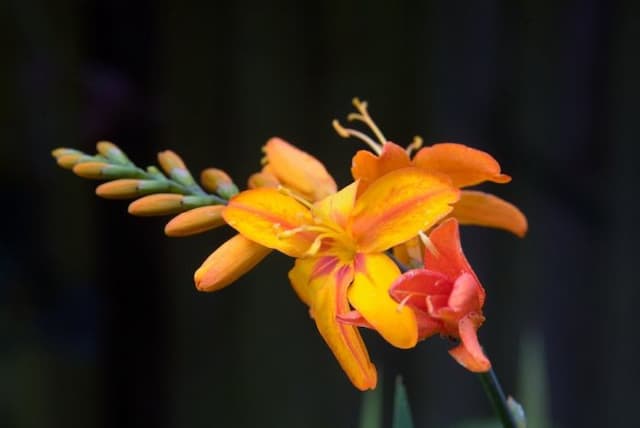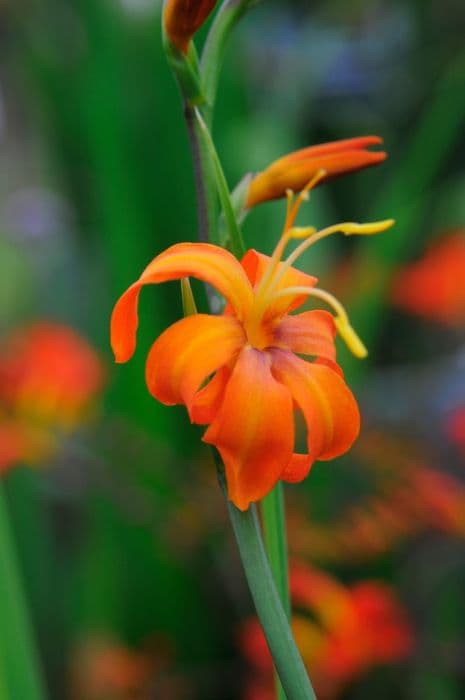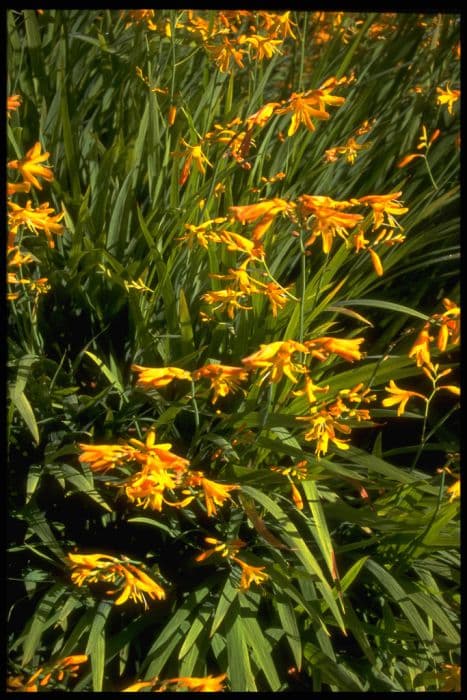Spuria Iris Iris 'Norton Sunlight' (Spuria)

ABOUT
Iris 'Norton Sunlight' is a striking plant with showy characteristics that set it apart in any garden setting. This particular variety, which falls under the family commonly known as the Spuria Iris, flaunts a luxurious blend of colors resonating a bright, sunny disposition. The foliage consists of long, slender leaves that elegantly arch outwards, creating a lush green backdrop for the captivating flowers. The flowers, which are the stars of this plant, exhibit a delightful sunny yellow hue that captures the essence of sunlight. These blooms are large and intricately shaped, featuring flaring falls, which are the petal-like parts that droop down, and smaller, upright-standing standards, giving the flower a majestic and three-dimensional appeal. The petals show off a delicate texture, sometimes exhibiting soft ruffling, which adds to their ornate appearance. Adding to the beauty, the flowers may display a subtle blending or veining of colors. The throat of each bloom, which is the innermost part near the base of the standards and falls, could accentuate with a slightly different shade or have intricate patterning that draws in both pollinators and human admirers alike. These blooms are often perched atop slender, sturdy stems that gracefully rise above the foliage. The Spuria Iris, like its 'Norton Sunlight' variant, is appreciated for its elegant form and its ability to add a burst of color reminiscent of a bright, sunny day. Its overall form is balanced, with the foliage creating a vertical element and the blossoms providing a cheerful display when in bloom. The overall impression created by this plant is one of elegance, vibrancy, and a touch of sophistication that can enhance the aesthetic of any space it graces.
About this plant
 Names
NamesFamily
Iridaceae.
Synonyms
Norton's Sunlight Spuria Iris, Yellow Spuria Iris.
Common names
Iris 'Norton's Sunlight'.
 Toxicity
ToxicityTo humans
The Spuria Iris, like many other iris species, contains compounds that are potentially toxic to humans. These compounds are primarily concentrated in the rhizomes, although all parts of the plant should be considered to have toxic potential. When parts of the plant, especially rhizomes or roots, are ingested by humans, they can cause digestive upset, characterized by symptoms such as nausea, vomiting, abdominal pain, and diarrhea. Handling the plant may also cause skin irritation due to the presence of these compounds in the sap. To avoid poisoning, take care not to ingest any part of the plant and wash hands thoroughly after handling it.
To pets
The Spuria Iris is toxic to pets as well, with the rhizomes being the most toxic part. If ingested by pets, such as cats and dogs, the toxic substances can cause gastrointestinal upset which may result in symptoms including vomiting, drooling, diarrhea, or abdominal pain. In severe cases, it might also affect the central nervous system leading to other symptoms such as lethargy or depression. It is crucial to keep pets from chewing on any part of the plant and to seek veterinary attention if ingestion is suspected.
 Characteristics
CharacteristicsLife cycle
Perennials
Foliage type
Deciduous
Color of leaves
Green
Flower color
Yellow
Height
3-4 feet (91-122 cm)
Spread
1-2 feet (30-61 cm)
Plant type
Bulb
Hardiness zones
Varies
Native area
Mediterranean
Benefits
 General Benefits
General Benefits- Ornamental Value: 'Norton Sunlight' adds aesthetic appeal to gardens with its bright yellow flowers and elegant, tall form.
- Drought Tolerance: As a Spuria iris, it is well-suited to withstand dry conditions once established.
- Low Maintenance: It generally requires minimal care beyond initial planting and occasional division.
- Attracts Pollinators: Flowers provide nectar and attract bees, beneficial for pollination of gardens.
- Deer Resistance: Typically avoided by deer, which is advantageous for gardeners in areas with deer populations.
- Adaptability: It can thrive in a variety of soil conditions, although it prefers well-drained soils.
- Seasonal Interest: Blooms in late spring to early summer, providing seasonal color when many other plants are not in peak bloom.
- Use in Cut Flower Arrangements: The tall, sturdy stalks and attractive blooms are ideal for fresh floral arrangements.
 Medical Properties
Medical PropertiesThis plant is not used for medical purposes.
 Air-purifying Qualities
Air-purifying QualitiesThis plant is not specifically known for air purifying qualities.
 Other Uses
Other Uses- Photography and Painting Subject: Because of its striking appearance, the Spuria Iris can serve as an inspiring subject for photographers and artists, particularly those interested in botanical themes.
- Garden Design Element: With its distinctive flowers, the Spuria Iris can be used to create focal points or to add vertical accents in garden designs and landscapes.
- Educational Tool: Botany students and enthusiasts may use the Spuria Iris to study plant anatomy, especially the unique structures of its flowers and rhizomatous growth patterns.
- Bioindicator: The Spuria Iris might be utilized as a bioindicator to gauge the health of a particular ecosystem, especially in wetland areas where Irises commonly grow.
- Artisan Dyes: The petals of the Spuria Iris can potentially be used to produce natural dyes for textile art, though this is an uncommon practice and would require experimentation.
- Cut Flower Arrangements: The tall, elegant flowers of the Spuria Iris can be used in cut flower arrangements and are especially valued for their longevity in vases.
- Fragrance Extraction: While not commonly used for this purpose, the flowers of Spuria Iris may be explored for essential oil extraction to produce unique fragrances.
- Erosion Control: Planted in large groups, Spuria Iris can help stabilize soil and prevent erosion along stream banks or in other wetland environments.
- Companion Planting: The Spuria Iris can be used in companion planting to add height and color contrast among other water-loving garden plants.
- Dried Flower Crafts: The seed pods and dried flowers of Spuria Iris hold their structure well and can be incorporated into dried flower arrangements and crafts.
Interesting Facts
 Feng Shui
Feng ShuiThe Iris is not used in Feng Shui practice.
 Zodiac Sign Compitability
Zodiac Sign CompitabilityThe Iris is not used in astrology practice.
 Plant Symbolism
Plant Symbolism- Hope - The Iris generally symbolizes hope, representing belief in a better future.
- Trust - It's a plant that conveys trust, embodying the faith we place in others.
- Wisdom - Historically associated with royalty and the gods, the Iris carries the weight of wisdom.
- Courage - Due to its sturdy nature, the Iris can also symbolize courage and admiration.
- Purity - With its bright blooms, it is often linked to purity and innocence.
 Water
WaterFor the Spuria Iris, watering should be done thoroughly, ensuring the soil is moist but well-drained. During the growing season, water approximately every week, supplying about 1-1.5 inches of water each time, which equates to about 0.5 to 0.8 gallons per plant. During periods of high heat or extreme dryness, increase watering frequency. After blooming and in dormant periods, reduce watering to prevent root rot but do not allow the soil to completely dry out.
 Light
LightSpuria Iris thrives best in full sun conditions, receiving at least 6 to 8 hours of direct sunlight daily. The ideal spot for this plant is in an area with unfiltered, continuous sunlight throughout the day. Avoid placing it in areas where buildings or trees cast significant shadows for prolonged periods.
 Temperature
TemperatureThe Spuria Iris prefers temperate climates with temperatures ranging from 60°F to 90°F during the growing season. It can tolerate minimum temperatures down to about 20°F, but to ensure healthy growth, it should not be exposed to prolonged periods below freezing. The ideal temperature range is between 70°F and 80°F during active growth.
 Pruning
PruningPruning of the Spuria Iris is mainly to remove spent flower stalks and maintain plant appearance. Prune back foliage in the fall to tidy up the plant and prepare for winter, cutting back to a few inches above the ground. Pruning is typically only required once annually, immediately after the blooming season has ended.
 Cleaning
CleaningAs needed
 Soil
SoilThe best soil mix for Spuria Iris should be well-draining with a neutral to slightly alkaline pH between 6.5 and 8.0. A mix containing loamy garden soil amended with sand and compost will provide the nutrients and drainage these irises need.
 Repotting
RepottingSpuria Iris, or Sawtooth Iris, generally does not require frequent repotting and can be done every 3 to 5 years, or when the clump becomes overcrowded and flowering diminishes.
 Humidity & Misting
Humidity & MistingSpuria Iris, also known as Sawtooth Iris, is tolerant of a wide range of humidity levels and does not have specific humidity requirements.
 Suitable locations
Suitable locationsIndoor
Provide full sun, well-draining soil, and slight drying between waterings.
Outdoor
Plant in full sun in well-drained soil, water moderately.
Hardiness zone
4-9 USDA
 Life cycle
Life cycleThe life cycle of Spuria Iris 'Norton Sunlight' starts with seed germination, where seeds planted in the soil begin to sprout typically in late winter or early spring. Following germination, the seedlings develop into young plants with a small rosette of leaves at the soil level. As the plants mature, they form long, narrow, and erect foliage, and establish a robust root system including rhizomes. The Spuria Iris typically reaches flowering maturity in a few years, producing tall stems that bear unique yellow or light-colored blooms typically in late spring to early summer. After flowering, the plant sets seed, which can be harvested and sown or naturally dispersed. Over years, the rhizomes may become crowded and require division (usually done after flowering), to rejuvenate the plant and encourage vigorous growth for the following seasons.
 Propogation
PropogationPropogation time
Late summer to early fall
The most popular method of propagation for Iris 'Norton Sunlight', commonly known as the Spuria Iris, is through division of its rhizomes. This is typically done in late summer after the blooms have faded and the foliage has started to die back. Gardeners should carefully dig up the clumps of rhizomes, gently wash off the soil, and inspect them for signs of disease or damage. Using a clean, sharp knife, the rhizomes are cut into pieces, ensuring that each division has at least one healthy fan of leaves and a portion of the roots. The cut surfaces are often allowed to dry and callus over for a few hours to a day to prevent rot. The divisions are then planted in well-drained soil at a depth of about 2 to 4 inches (5 to 10 cm), spaced 12 to 24 inches (30 to 60 cm) apart to allow for ample growth. With proper care, these divisions will establish themselves and potentially bloom the following year.
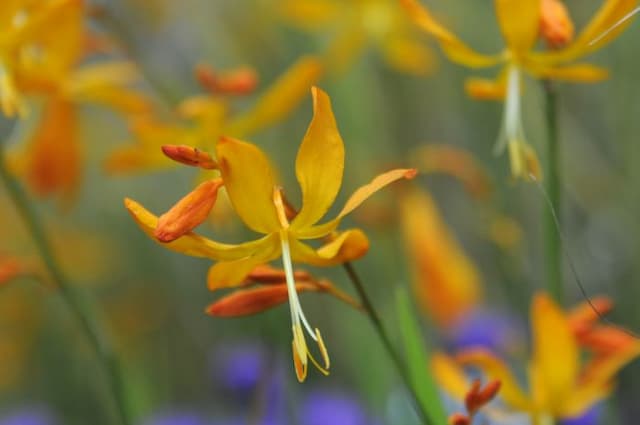
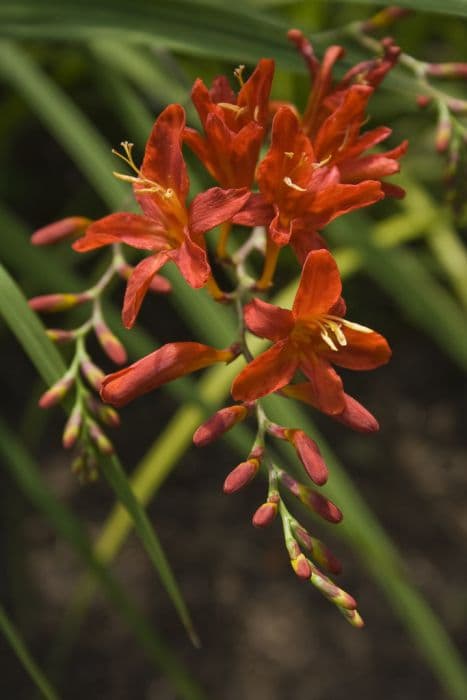
![Montbretia [Bright Eyes]](/_next/image?url=https%3A%2F%2Fplants-admin.emdemapps.com%2Fimages%2Fplants%2F%2Fimages%2F604b5f4a483b6.png&w=640&q=75)
